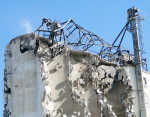'Maywood Tombstone' silenced critics in 1946; career ended by wrecking crew

MAYWOOD, Nebraska -- A front-end loader attached by a steel cable to metal frame-work on the top of grain storage bins eight stories in the air tugged a couple times late Wednesday morning, and what had been the headhouse perched at the top of Ag Valley Coop's "south house" storage bins came crashing to the ground.
The framework didn't put up much of a fight -- the Forest River Colony construction company of Fordville, North Dakota, had already removed its siding, and, throughout the morning Wednesday, Gary Korby and Nevin Maendel severed all its connections to the storage bins' roof with cutting torches before retreating to the ground in a basket suspended from a Korby Construction crane.
On the ground, Martin Maendel operated the front-end loader to bring the frame-work -- twisting and screeching -- to the ground.

The removal of the headhouse was one of the preliminary steps in the demolition of the elevator and storage bins.
Using a wrecking ball swinging from a crane, Forest River crews started Monday to chew away at the 17 exterior storage bins. There are nine interior bins.
Charla Werkmeister, manager of Ag Valley Co-Op's Maywood operation, said crews are hammering away at the walls of the reinforced-concrete bins. "They'll keep chipping away until it's all gone," she said Wednesday. The process is expected to take several weeks.

Werkmeister said that high winds are a concern; work has been halted -- or the crane lowered -- if the wind is too strong.
To those out-of-the-know about the science of grain elevators, grain storage bins and grain dust, Werkmeister eases concerns about grain dust explosion. "Without confinement, without dust in suspension and without an ignition source, there can be no grain dust explosion," she said.
The elevator and its storage bin annex were built in 1946 for $61,338. Many patrons felt it would never fill, and called it "The Maywood Tombstone." A good harvest that year filled all available storage and silenced the critics.

The elevator and storage bins, however, through the years, have deteriorated to a point where it would cost more for repairs than the facility is worth.
The demolition of the south elevator and grain bins still leaves the Maywood co-op with "right at 2 million bushels" of storage, Werkmeister said.
